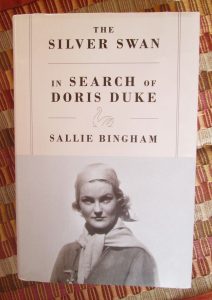In 1961, when I was sixteen, I spent the summer at a grand mansion on the Penobscot Bay in Maine. My German maternal grandmother was one of many live-in servants who worked for the wealthy couple whose summer residence this was. My grandmother was in her early seventies at that time and tired; I was there to assist her with her laborious work.
This experience immersed me in a world most of us never see in person: the world of the super-rich. And I came away feeling deeply — and indelibly — that their lives are far from enviable.
To me, as a shy and naïve (but observant) sixteen-year-old, the woman of the house, or “Madam,” as my grandmother and the rest of the household help called her, seemed to be straightjacketed by conventions and expectations. Why, she can’t even walk into her own enormous kitchen and make herself a ham-and-cheese sandwich! I thought to myself then. The cook would have had to do that for her. The Madam appeared to me to be helpless. Even pitiable. She wasn’t free.
So when I read my friend Sallie Bingham’s newly published biography of the American heiress Doris Duke – The Silver Swan: In Search of Doris Duke (Farrar, Straus, Giroux) – I was struck most of all by Doris’s rebelliousness. Here was a woman born to great wealth, who inherited $50 million at age thirteen in 1925 when her tobacco-tycoon father died (and who later grew that inheritance to more than $1 billion), who was branded “the world’s richest girl,” but who spent most of her life defying the conventions of her class.
As Sallie writes, “Throughout her life, she [Doris] would always seek to escape confinement.” I can certainly understand why.

Raised as an only child (by servants) in her parents’ limestone mansion on Fifth Avenue and 78th Street in New York and at their Duke Farms in Somerville, New Jersey, Doris grew to be a tall, elegant, charming, stylish, athletic and supremely private woman. She kept no diaries, wrote few letters, and gave even fewer interviews. She was, says Sallie, “determined to shield herself from scrutiny.”
Handsome, dashing, fortune hunters were attracted to her for more than her talents and her charms. She was married twice – briefly – and had numerous lovers – some crossing “the color line that defined propriety,” as Sallie puts it — and she was always the first to break off the relationship. She worked – also briefly — as a war correspondent, as well as a minor undercover agent for the OSS, during WWII.
Among her many notable friends were General George Patton, Eleanor Roosevelt, Clare Boothe Luce, Duke Ellington, Jackie Onasis, Anne Morrow Lindbergh, and Imelda Marcos.
In addition to her whirlwind travels all over the world, Doris owned and managed five grand estates in the U.S. simultaneously and moved among them regularly — the Fifth Avenue mansion; Duke Farms in New Jersey; a “cottage” (mansion) named Rough Point in Newport, Rhode Island; her “Shangri La” in Honolulu, Hawaii (which would ultimately house Doris’s world-famous collection of Islamic art); and Falcon’s Lair, in Bel Air, California, where she died at the age of eighty in October 1993.
At her death Doris owned ten thousand pieces of clothing, all worn. But, says Sallie, “the amount she spent on her own indulgences is small” in comparison to what she gave away: $400 million during her lifetime, through some twenty charitable organizations she’d established to support the causes that most interested her, among them the welfare of women and children, education, mental health, and family planning.
“If Shangri La [which is now a museum] had been her only notable achievement and donation to the public,” Sallie writes, “Doris Duke would still deserve to be remembered as a very farsighted philanthropist.”
Author Sallie Bingham (83) is herself an heiress and philanthropist, so she knows firsthand the inner workings of the world that Doris Duke inhabited. More so than others could, Sallie can, and does, write about Doris with empathy and compassion. And, I believe, as an avowed feminist Sallie appreciates Doris’s prototypical feminism – and the courage it took to be herself in the era and the world in which she lived.
~ ~ ~
Please see my WOW interview with Sallie of July 24, 2014, when she was embarking on her Doris Duke biography: www.blog.bonnieleeblack.com/Sallie-Bingham/ . And be sure to visit Sallie’s exciting website to learn more about The Silver Swan, watch a video of Sallie reading from it, and read about her many other published books and plays: www.salliebingham.com . The Silver Swan is Sallie’s fourteenth book.
